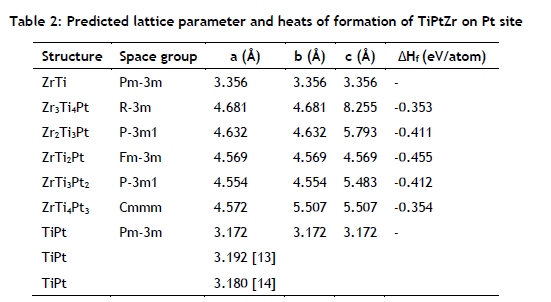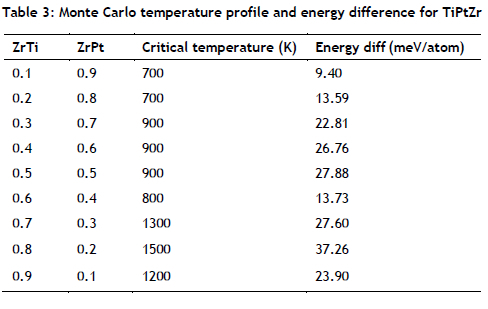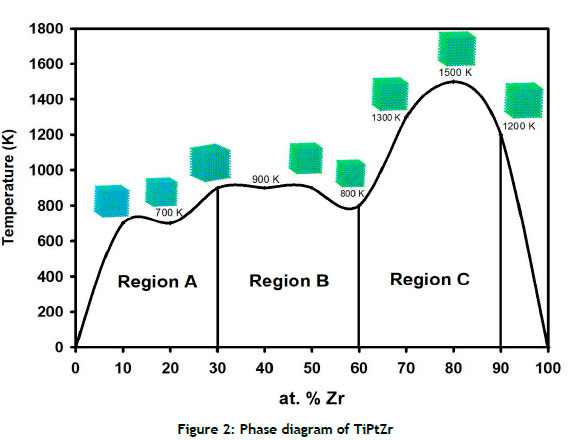Servicios Personalizados
Articulo
Indicadores
Links relacionados
-
 Citado por Google
Citado por Google -
 Similares en Google
Similares en Google
Compartir
South African Journal of Industrial Engineering
versión On-line ISSN 2224-7890
versión impresa ISSN 1012-277X
S. Afr. J. Ind. Eng. vol.33 no.3 Pretoria nov. 2022
http://dx.doi.org/10.7166/33-3-2807
SPECIAL EDITION
Phase stability of TiPtZr shape memory alloys using cluster expansion techniques
M. Mashamaite*; P. Ngoepe; H. Chauke
Materials Modelling Center, School of Physical and Material Sciences, University of Limpopo, South Africa
ABSTRACT
Titanium-Platinum (TiPt) has a martensitic transformation of about 1300 K, making it potential material for use as a high-temperature shape memory alloy. A third element is expected to improve the properties of TiPt alloys for future use in the aerospace industry. In this study, the effect of the addition of Zr on the stability of TiPt was investigated using the cluster expansion method employing the UNCLE code. A total of 21 new structures on the Pt site and 22 new structures on the Ti site were generated. Only seven (7) structures constituted the ground-state line for the Pt site, and six (6) structures for the Ti site, which suggested that these structures were the most thermodynamically stable phases. The ZrTi2Pt phase was the most thermodynamic stable with heats of a formation value of - 0.455 eV/atom on the Pt site. Thus, a phase diagram for the TiPtZr system was constructed. The findings of this study could benefit the design of new materials in the aerospace industry.
OPSOMMING
Titaan-Platinum (TiPt) het 'n martensitiese transformasie van ongeveer 1300 K, wat dit 'n potensiële materiaal maak vir gebruik as 'n hoë-temperatuur vormgeheue-legering. 'n Derde element sal na verwagting die eienskappe van TiPt-legerings verbeter vir toekomstige gebruik in die lugvaartbedryf. In hierdie studie is die effek van die byvoeging van Zr op die stabiliteit van TiPt ondersoek deur gebruik te maak van die groepuitbreidingsmetode wat die UNCLE kode gebruik. Altesaam 21 nuwe strukture op die Pt-terrein en 22 nuwe strukture op die Ti-terrein is gegenereer. Slegs sewe strukture het die grondtoestandlyn vir die Pt-terrein gevorm, en ses strukture vir die Ti-terrein, wat daarop dui dat dit die mees termodinamies stabiele fases was. Die ZrTi2Pt fase is die mees energeties stabiele met hitte van 'n formasie waarde van - 0.455 eV/atoom op die Pt terrein. Dus is 'n fasediagram vir die TiPtZr-stelsel saamgestel. Die bevindinge van hierdie studie sal tot voordeel van die ontwerp van nuwe materiale in die lugvaartindustrie wees.
1. INTRODUCTION
Shape memory alloys (SMAs) are materials that can preserve their pristine shape when exposed to temperature or load due to their unique thermomechanical properties [1, 2]. Two major attributes that make SMAs distinct from other materials are pseudoelasticity and shape memory effect (SME), which occur as a result of phase transformation [3]. SMAs have excellent potential for the development of applications, including in industries such as the automotive, aerospace, engineering, and medical industries [4, 5]. High-temperature shape memory alloys (HTSMAs) such as NiTi-M (M = Pt, Pd, Hf and Zr) have been studied for high temperatures above 373 K in order to increase their areas of application, but are limited to temperatures around 700 K [6]. TiPt is more promising as a HTSMA, since it has a higher martensitic transformation of above 1300 K [7], and Pt has better high temperature properties. However, TiPt was reported to be mechanically unstable due to its negative shear modulus (C'= -32). In this study, the ground-state structures and phase stability of B2 TiPtZr using the cluster expansion method were investigated.
Monte-Carlo simulations were used to determine the phase changes and high-temperature properties of mixed TiPtZr alloys on the Pt site.
2. COMPUTATIONAL METHODOLOGY
2.1. Cluster expansion
Cluster expansion (CE) calculations were done using the program Universal Cluster Expansion (UNCLE) code [8]. The code can perform a complete CE fit using a genetic algorithm, and predict the ground states of systems containing three elements. This method was used to determine the ground-state structure and thermodynamic properties of TiPtZr alloys. The fitness of every figure set was evaluated using the cross-validation score (CVS), which quantifies the predictive accuracy of the figure set for an unknown structure [9].
2.2. Total-energy calculations
The total-energy calculations of TiPtZr alloys were performed using the Vienna Ab initio Simulation Package (VASP) [10]. An energy cut-off of 500 eV was used for the plane-wave expansion of wave functions. The generalised gradient approximation (GGA) function of Perdew-Burke-Ernzerhof (PBE) was introduced to describe the exchange-correlation energy [11]. The k-spacing of 0.2 was used, according to the Monkhorst and Pack grid, for specified k-point sampling [12]. Full geometry optimisation was performed on the ground-state structures.
2.3. Monte Carlo simulation
A Monte Carlo simulation was used to determine the phase diagram of the TiPtZt alloys. A phase diagram was constructed from their critical temperatures. Monte Carlo simulations were performed using the UNCLE code [8] for TiPtZt alloys. The averaging times for the given precision on the average concentration of the alloy were set to 0.1%. The MC moves consisted of exchanging the position of the Pt and Zt atoms. The phase diagrams were computed using the canonical ensemble (NVT) specified by the system volume (V), number of particles (N), and temperature (T) as implemented in the UNCLE code [8]. Periodic boxes containing 25 x 25 x 25 atoms were used. The temperature was varied from 100 K to 3000 K.
3. RESULTS
3.1. Ground-state structures
Table 1 shows the characteristics of the calculated cluster expansions for B2 TiPtZr for both Pt and Ti sites. The cluster expansion generated 21 structures with seven ground-state structures on the Pt site and 22 structures with six ground-state structures on the Ti site. The cross-validation score (CVS) was used to evaluate the predictive power of the cluster expansion. A small CVS < 5 indicates the fitting accuracy of the cluster expansion. The cluster expansion of the B2 TiPtZr was found to have a CVS of 0.026 meV/atom on the Pt site and 4 meV/atom on the Ti site.

In Figure 1, the red line represents the density functional theory (DFT) ground-state line, while the green squares with a cross inside represent predicted structures. It is noted that all formation energies/heats of formation are negative, and form the vertices on the lower boundary of the convex for TiPtZr (Pt site) ordered structures. This behaviour suggests that the structures are thermodynamically stable. Furthermore, the ground-state line predicted five stable structures relative to the predicted formation energies for TiPtZr alloys. Among the stable structures, ZrTi2Pt is the most thermodynamically stable structure because it has the lowest ΔHf compared with other structures.
3.2. Structural and thermodynamic properties
In Table 2, the equilibrium lattice parameters and heats of formation of the TiPtZr structures are presented. The new crystal structures were cubic (Pm3m and Fm3m), orthorhombic (Cmmm), and trigonal systems with space groups (R-3m and P3-m1). The binary TiPt results were in good agreement with the available experimental and theoretical data. In particular, the lattice parameters of the cubic TiPt (Pm-3m) agreed to within 2%. The heats of formation were determined to verify the existence of the binary phases. The heats of formation (AHf) were estimated by the following expression [12]:


where Ec is the calculated total energy of the compound and E is the calculated total energy of the element in the compound. All of the predicted structures were thermodynamically stable owing to the negative values. The most stable structure was found to be ZrTi2Pt with the lowest heats of formation of (-0.455) eV/atom. The stability trend in the calculated ΔHf for the predicted structure in cluster expansions is as follows: ZrTi2Pt > ZrTi3Pt2 > Zr2Ti3Pt > ZrTi4Pt3 > Zr3Ti4Pt.
3.3. Phase diagram
The determined critical temperature was used to construct a phase diagram concerning the compositions of Zr on the Pt site, as shown in Table 3. Ten different Monte Carlo simulations, with the ZrPt concentrations on the active site set from 0.9 to 0.1 and ZrTi set from 0.1 to 0.9. In addition, the energies of TiPtZr alloys were allowed to change in the calculation owing to changes in the occupation atom exchanges. The energy difference between atoms fluctuated with an increase in temperature.

The phase diagram of the computed TiPtZr alloys is shown in Figure 2. A Monte Carlo simulation was used to check the mixing of the two phases as implemented in the UNCLE code [8]. The ensemble of choice was the canonical ensemble (NVT) for the TiPtZr on the Pt site to evaluate the critical temperature. A phase-non-separating tendency was observed at temperatures around 700 K (Region A). However, it could also be seen that no phase separation occurred for the TiPtZr (Pt Site) system at temperatures above 700 K (Region B), and the system mixed very well below 1600 K (Region C), which indicated rapid diffusion. This was a result of the physical properties of the individual elements (Ti, Pt and Zr), and thus they tend to mix very well. Therefore, the phase diagrams were successfully developed using Monte Carlo simulations.

4. CONCLUSION
The phase stability of TiPtZr alloys based on density functional theory was studied using cluster expansion techniques. The cluster expansion method successfully generated a total of 43 new structures; 21 new structures on B2 TiPtZr (Pt site) and 22 new structures on B2 TiPtZr (Ti site). This method was successfully used to determine the ground-state structure and the phase diagram of the TiPtZr system on the Pt site. All formation energies were found to be negative, which suggested no phase separation. Furthermore, the ZrTi2Pt (Fm-3m) system was found to be thermodynamically stable owing to the lowest heats of formation at -0.455 eV/atom. The phase diagrams of TiPtZr on the Pt site were successfully constructed using Monte Carlo simulations. Our prediction was that the system could be used for HTSMAs applications.
5. ACKNOWLEDGEMENT
The simulations were conducted using computer resources at the Materials Modelling Centre (MMC) at the University of Limpopo and the Centre for High Performance Computing (CHPC) in Cape Town. The authors recognise the South African Research Chair Initiative of the Department of Science and Innovation (DSI), the National Research Foundation, the Titanium Centre of Competence (TiCoC) of the Council for Scientific and Industrial Research (CSIR), and the Advanced Materials Initiative (AMI), all of which are acknowledged with deep gratitude.
REFERENCES
[1] J. M. Jani, M. Leary, A. Subi, & M. A. Gibson, "A Review of Shape Memory Alloy Research, Applications and Opportunities," Mater. Des., vol. 56, pp. 1078-1113, 2014. [ Links ]
[2] A. H. M. M. Billah, J. Rahman, & Q. Zhang, "A State-Of-The-Art Review on The Application of Shape Memory Alloys (SMAs) In Bridges: Research And Opportunities," Structures, vol. 37, pp. 514-527, 2022. [ Links ]
[3] S. Zareie & A. Zabihollah, Emerging trends in mechatronics, London: IntechOpen, 2020. [ Links ]
[4] G. L. Zhao & B. N. Harmon, "Electron-Phonon Interactions and the Phonon Anomaly in ß-phase NiTi," Phys. Rev. B., vol. 48, pp. 2031-2036, 1993. [ Links ]
[5] G. Costanza & M. E. Tata, "Shape Memory Alloys for Aerospace, Recent Developments, and New Applications: A Short Review," Mater., vol. 13, pp. 1-16, 1856, 2020. [ Links ]
[6] J. Ma, I. Karaman, & R. Noebe, "High Temperature Shape Memory Alloys," Int. Mater. Rev., vol. 55, pp. 257-315, 2010. [ Links ]
[7] H. C. Donkersloot & J. H. N. van Vucht, "Martensitic Transformations in Gold-Titanium, Palladium-Titanium And Platinum-Titanium Alloys Near The Equiatomic Composition," 1970 J. Less Comm. Met., vol. 20, pp. 83-91, 1970. [ Links ]
[8] D. Lerch, O. Wieckhorst, G. L. W. Hart, R. W. Forcade, & S. Müller, "UNCLE: UNCLE: A Code for Constructing Cluster Expansions For Arbitrary Lattices With Minimal User-Input," Modelling Simul. Mater. Sci. Eng., vol. 17, pp. 1-19, 55003, 2009. [ Links ]
[9] A. van de Walle, M. Asta, & G. Ceder, "The Alloy Theoretic Automated Toolkit: A User Guide," Calphad, vol. 26, pp. 539-553, 2002. [ Links ]
[10] G. Kresse & J. Hafner, "Ab initio Molecular Dynamics for Liquid Metals," Phys. Rev. B., vol. 47, pp. 558-561, 1993. [ Links ]
[11] J. P. Perdew, K. Burke, & M. Ernzerhof, "Generalized Gradient Approximation Made Simple," Phys. Rev. Lett. vol. 77, pp. 3865-3868, 1996. [ Links ]
[12] G. W. Fernando, R. E. Watson, & M. Weinert, "Heats of Formation of Transition-Metal Alloys: Full-Potential Approach and the Pt-Ti System," Phys. Rev. B. vol. 45, no. 15, pp. 8233-8238 ,1992. [ Links ]
[13] H. J. Monkhorst & J. D. Pack, "Special Points for Brillouin-Zone Integrations," Phys.Rev. B. vol. 13, pp. 5188 -5192, 1976. [ Links ]
[14] M. P. Mashamaite, H. R. Chauke, & P. E. Ngoepe, "B2 and B19 TiPtZr High Temperature Shape Memory Alloys," in Proceeding of AMI-SAIMM, Polokwane, South Africa, pp.191-202, 2017. [ Links ]
* Corresponding author: mordecai.mashamaite@gmail.com
ORCID® identifiers
M. Mashamaite: 0000-0002-3370-9732
P. Ngoepe: 0000-0003-0523-5602
H. Chauke: 0000-0003-2603-5941














